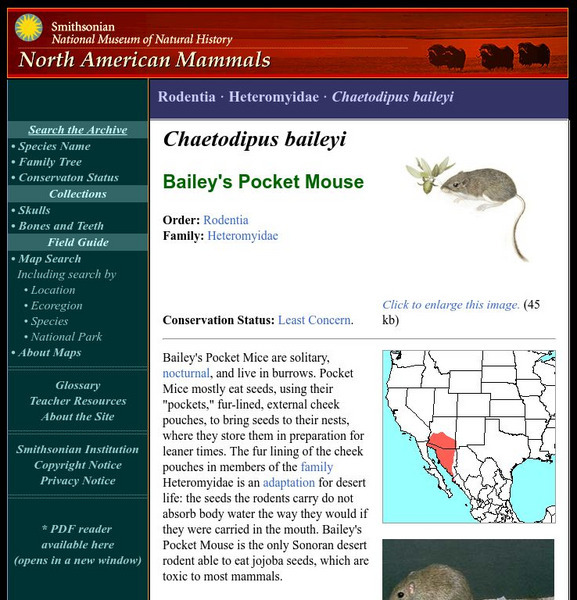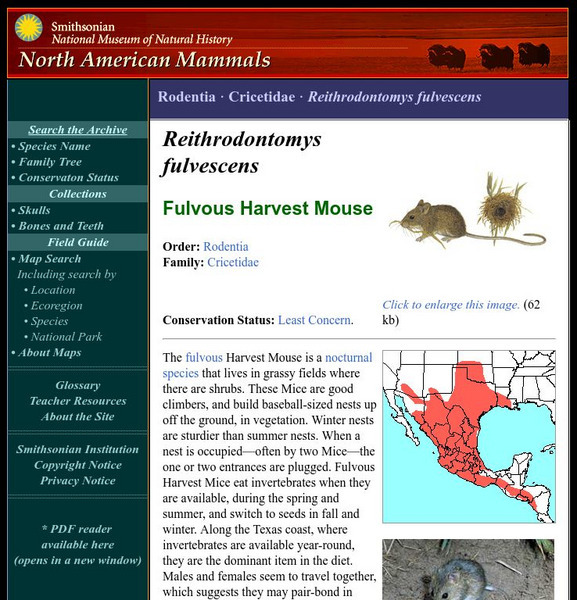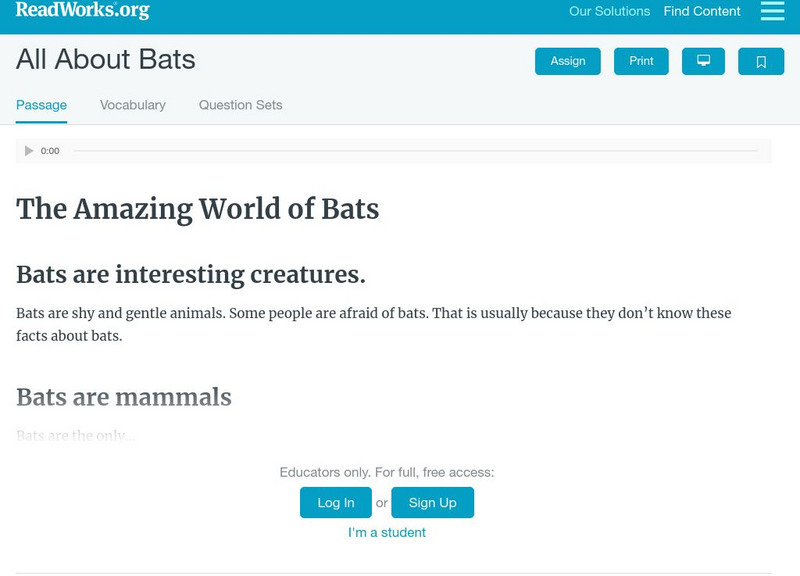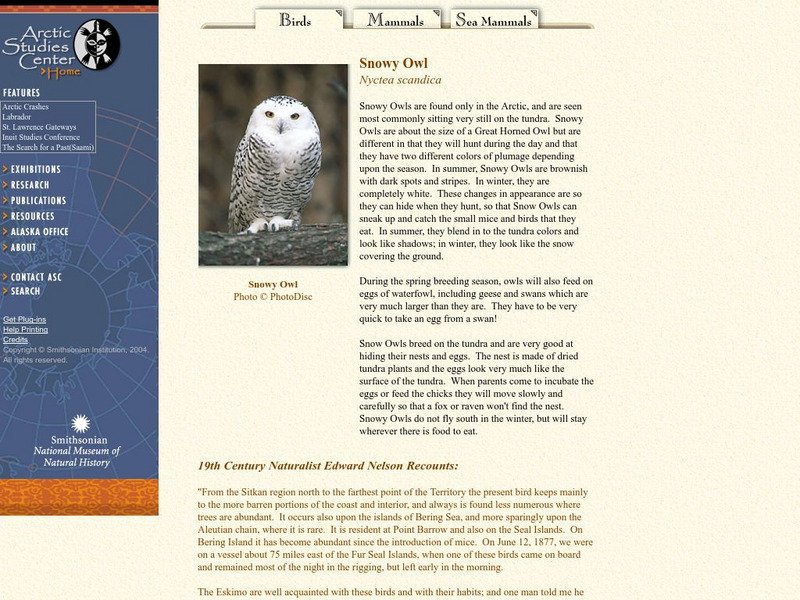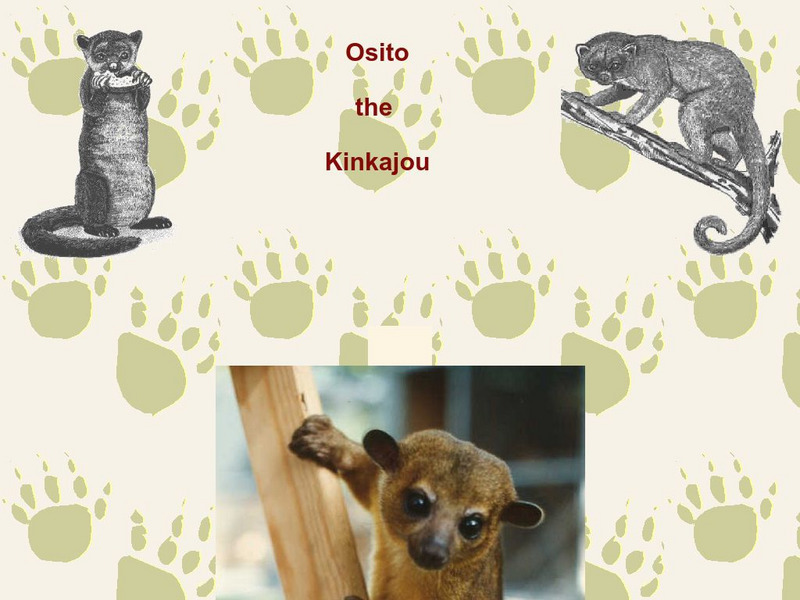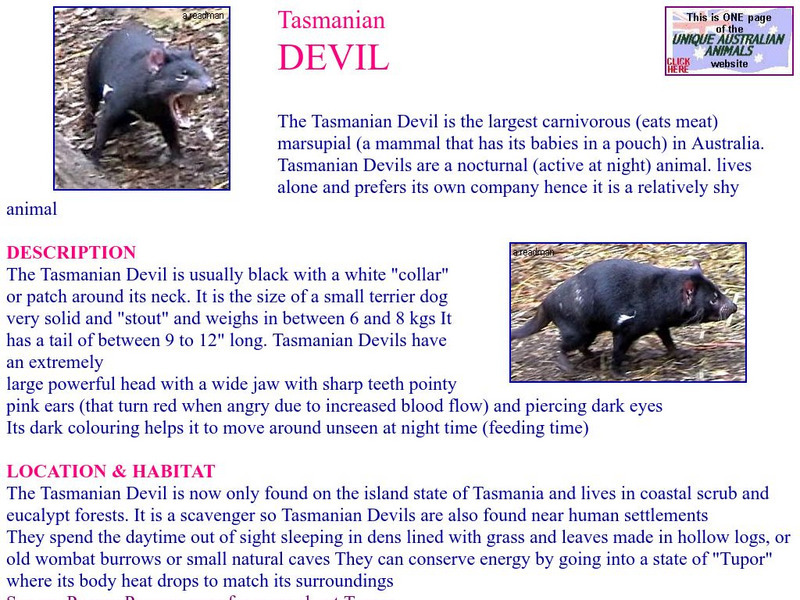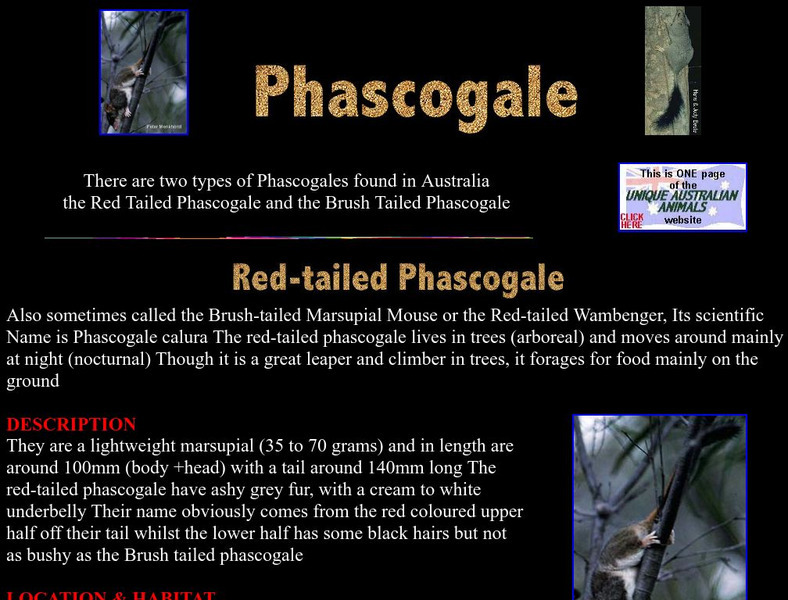Hi, what do you want to do?
Smithsonian Institution
National Museum of Natural History: American Mammals: Bailey's Pocket Mouse
Bailey's Pocket Mice are solitary, nocturnal, and live in burrows. Pocket Mice mostly eat seeds, using their "pockets," fur-lined, external cheek pouches, to bring seeds to their nests, where they store them in preparation for leaner...
Smithsonian Institution
National Museum of Natural History: American Mammals: Cinereus Shrew
Mainly nocturnal and rarely seen, the Cinereus Shrew is nonetheless common and widespread below the timberline in northern deciduous and coniferous forests, in both wet and dry habitats. It is also known as the Masked Shrew and the...
Smithsonian Institution
National Museum of Natural History: American Mammals: Southern Short Tailed Shrew
The Southern Short-tailed Shrew is a highly active, primarily nocturnal predator. It is most common in moist, well-drained hardwood forests or pine stands, especially where deep organic litter provides easy burrowing for shelter and...
Smithsonian Institution
National Museum of Natural History: American Mammals: Snowshoe Hare
The Snowshoe Hare is broadly distributed in the north from coast to coast and occurs in a variety of habitat types, including swamps, hardwood forests, and mixed and evergreen forests. Nocturnal like most members of the family, this hare...
Smithsonian Institution
National Museum of Natural History: American Mammals: White Eared Pocket Mouse
One subspecies of the White-eared Pocket Mouse may be extinct, and the other is extremely rare, consisting of isolated, relict populations near the western Mojave Desert in California. White-eared Pocket Mice are nocturnal and probably...
Smithsonian Institution
National Museum of Natural History: American Mammals: Ringtail
Ringtails are nocturnal, cat-sized carnivores. They are good climbers and are found in habitats that range from dry canyons to wet woodlands, in highland and lowland terrain. Learn more about the Bassariscus astutus, more commonly known...
Smithsonian Institution
National Museum of Natural History: American Mammals: Swift Fox
Swift foxes are primarily nocturnal, but can sometimes be seen sunning themselves near the entrance to a den. They live on prairie grasslands just east of the Rocky Mountains. Learn more about the Vulpes velox, more commonly known as a...
Smithsonian Institution
National Museum of Natural History: American Mammals: Fulvous Harvest Mouse
The fulvous Harvest Mouse is a nocturnal species that lives in grassy fields where there are shrubs. These Mice are good climbers, and build baseball-sized nests up off the ground, in vegetation. Learn more about the Reithrodontomys...
Read Works
Read Works: All About Bats
[Free Registration/Login Required] This nonfiction passages describes the characteristics of bats. This passage is a stand-alone curricular piece that reinforces essential reading skills and strategies and establishes scaffolding for...
Read Works
Read Works: A Real Life Bat Man
[Free Registration/Login Required] This passage describes the responsibilities of a chiroptologist, a person who studies bats for a living. This passage is a stand-alone curricular piece that reinforces essential reading skills and...
Smithsonian Institution
National Museum of Natural History: Snowy Owl
This Smithsonian website has a brief, but thorough, article on the Snowy Owl that also includes a picture and an extensive quote from the 19th Century naturalist Edward Nelson.
Other
Osito the Kinkajou
Learn about kinkajous from a scientific standpoint, their habitat, behavior, diet, and the like--and learn how to keep these South American animals as pets.
Smithsonian Institution
National Museum of Natural History: Hall of Mammals: Bushbaby
Brief illustrated overview of the bushbaby and an accompanying video demonstrate the physical adaptations that allow this animal to communicate with family members.
Canadian Museum of Nature
Canadian Museum of Nature: Striped Skunk
The Canadian Museum of Nature offers a detailed drawing of a striped skunk followed by a brief description of the animal.
Scientific American
Scientific American: A Promenade With Prosimians
This article, published by Scientific American (September 2002), takes a look at the lemurs and their next of kin at the Duke Primate Center.
Unique Australian Animals
Unique Australian Animals: Tasmanian Devil
The Tasmanian devil is a real Australian marsupial mammal and nothing like the cartoon character as you will find out in this illustrated article.
Unique Australian Animals
Unique Australian Animals: Red Tailed Phascogale
Discover the Australian red-tailed phascogale, also called the brush-tailed marsupial mouse, in this illustrated article.
Enchanted Learning
Enchanted Learning: Wild Skunks
Here you can find all kinds of useful information about wild skunks, including how they "spray," what they eat, and what they look like.
Other
Port Discovery Children's Museum: Stem at Home: Bug Bingo
Did you know that there are more than 1.5 million species of named bugs? You can find so many bugs right in your own back or front yard and you can have some fun of your own playing the two Bug Bingo games.
Curated OER
Click to View Full Sized Image
Image of Whistler's painting, "Nocturn in Black and Gold: The Falling Rocket," with general information about the painting. Provides link to large image which can be made to adjust to the size of your screen.
Other popular searches
- Nocturnal Animals
- Nocturnal Animal Sounds
- Owls and Nocturnal Animals
- Preschool Nocturnal Animals
- Nocturnal Animals Lessons
- Nocturnal Animals Songs
- Nocturnal Desert Animals
- Poems for Nocturnal Animals
- K Nocturnal Animals
- Pre K Nocturnal Animals
- List Nocturnal Animals
- Tracks of Nocturnal Animals





